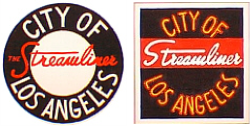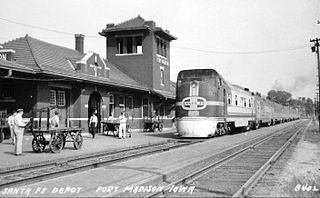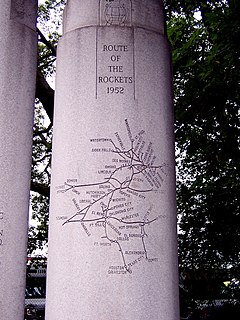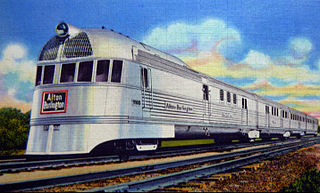
A streamliner is a vehicle incorporating streamlining in a shape providing reduced air resistance. The term is applied to high-speed railway trainsets of the 1930s to 1950s, and to their successor "bullet trains". Less commonly, the term is applied to fully faired upright and recumbent bicycles. As part of the Streamline Moderne trend, the term was applied to passenger cars, trucks, and other types of light-, medium-, or heavy-duty vehicles, but now vehicle streamlining is so prevalent that it is not an outstanding characteristic. In land speed racing, it is a term applied to the long, slender, custom built, high-speed vehicles with enclosed wheels.

The California Zephyr was a passenger train that ran between Chicago, Illinois and Oakland, California via Omaha, Denver, Salt Lake City, Winnemucca, Oroville and Pleasanton. It was operated by the Chicago, Burlington & Quincy (CB&Q), Denver & Rio Grande Western (D&RGW) and Western Pacific (WP) railroads, all of which dubbed it "the most talked about train in America" on March 19, 1949, with the first departure the following day. The train was scheduled to pass through the most spectacular scenery on its route in the daylight. The original train ceased operation in 1970, though the D&RGW continued to operate its own passenger service, the Rio Grande Zephyr, between Salt Lake City and Denver, using the original equipment until 1983. In 1983 a second iteration of the California Zephyr, an Amtrak service, was formed. The current version of the California Zephyr operates partially over the route of the original Zephyr and partially over the route of its former rival, the City of San Francisco.

The Chicago, Burlington and Quincy Railroad was a railroad that operated in the Midwestern United States. Commonly referred to as the Burlington Route, the Burlington, or as the Q, it operated extensive trackage in the states of Colorado, Illinois, Iowa, Missouri, Nebraska, Wisconsin, Wyoming, and also in Texas through subsidiaries Colorado and Southern Railway, Fort Worth and Denver Railway, and Burlington-Rock Island Railroad. Its primary connections included Chicago, Minneapolis–Saint Paul, St. Louis, Kansas City, and Denver. Because of this extensive trackage in the midwest and mountain states, the railroad used the advertising slogans "Everywhere West", "Way of the Zephyrs", and "The Way West".

The EMD E5 is a 2,000-horsepower (1,500 kW), A1A-A1A passenger train-hauling diesel locomotive manufactured by Electro-Motive Corporation, and its corporate successor, General Motors' Electro-Motive Division (EMD) of La Grange, Illinois, and produced exclusively for the Chicago, Burlington and Quincy Railroad, and its subsidiaries, during 1940 and 1941. The E5 was distinguished from the otherwise very similar E3, E4 and E6 by being clad in polished stainless steel to match the Burlington's Zephyr trains. It also featured unique small grill-like ornamentation on both sides of the upper headlight. Like the other models in the E-series, the E5 had a sloping “slant nose” and it was equipped with two headlights — a regular stationary headlight above a gyrating Mars signal light. The E5 was the sixth in the EMD E-unit series.

The City of Los Angeles was a streamlined passenger train between Chicago, Illinois, and Los Angeles, California via Omaha, Nebraska, and Ogden, Utah. Between Omaha and Los Angeles it ran on the Union Pacific Railroad; east of Omaha it ran on the Chicago and North Western Railway until October 1955 and on the Milwaukee Road thereafter. The train had number 103 westbound and number 104 eastbound.

The E9 is a 2,400-horsepower (1,790 kW), A1A-A1A passenger train-hauling diesel locomotive built by General Motors' Electro-Motive Division of La Grange, Illinois, between April 1954 and January 1964. 100 cab-equipped A units were produced and 44 cabless booster B units, all for service in the United States. The E9 was the tenth and last model of EMD E-unit and differed from the earlier E8 as built only by the newer engines and a different, flusher-fitting mounting for the headlight glass, the latter being the only visible difference. Since some E8s were fitted with this, it is not a reliable way to distinguish the two. The E9 has two 1,200 hp (895 kW), V12 model 567C engines, each engine driving one generator to power two traction motors.

The Flying Yankee was a diesel-electric streamliner built in 1935 for the Maine Central Railroad and the Boston and Maine Railroad by Budd Company and with mechanical and electrical equipment from Electro-Motive Corporation. It was also the name of a passenger train, the third streamliner train in North America. That train ceased passenger service in 1957 and is stored at the Hobo Railroad in New Hampshire and owned by the state of New Hampshire, which plans to open it to public viewing at some time in the future.

EMD E-units were a line of passenger train streamliner diesel locomotives built by the General Motors Electro-Motive Division (EMD) and its predecessor the Electro-Motive Corporation (EMC). Final assembly for all E-units was in La Grange, Illinois. Production ran from May 1937, to December, 1963. The name E-units refers to the model numbers given to each successive type, which all began with E. The E originally stood for eighteen hundred horsepower, the power of the earliest model, but the letter was kept for later models of higher power.

Electro-Motive Corporation produced five 1800 hp B-B experimental passenger train-hauling diesel locomotives in 1935; two company-owned demonstrators, #511 and #512, the Baltimore and Ohio Railroad's #50, and two units for the Atchison, Topeka and Santa Fe Railway, Diesel Locomotive #1. The twin engine power unit layout and multiple unit control systems developed with the B-B locomotives were soon adopted for other locomotives such as the Burlington Route's Zephyr locomotives built by the Budd Company in 1936 and EMC's own EMD E-units introduced in 1937. The B-B locomotives worked as proof-of-concept demonstrators for diesel power with the service loads of full size trains, breaking out of its niche powering the smaller custom Streamliners.

EMD F-units are a line of diesel-electric locomotives produced between November 1939 and November 1960 by General Motors Electro-Motive Division and General Motors-Diesel Division. Final assembly for all F-units was at the GM-EMD plant at La Grange, Illinois, and the GMDD plant in London, Ontario. They were sold to railroads throughout the United States, Canada and Mexico, and a few were exported to Saudi Arabia. The term F-unit refers to the model numbers given to each successive type, all of which began with the letter F. The F originally meant "fourteen", as in 1,400 horsepower (1,000 kW), not "freight". Longer EMD E-units for passenger service had twin 900-horsepower (670 kW) diesel engines. The E meant "eighteen" as in 1,800 horsepower (1,300 kW). Similarly, for early model EMD switchers, S meant "six hundred" and N meant "nine hundred horsepower".

The Budd Company was a 20th-century metal fabricator, a major supplier of body components to the automobile industry, and a manufacturer of stainless steel passenger rail cars, airframes, missile and space vehicles, and various defense products.

The Pioneer Zephyr is a diesel-powered trainset built by the Budd Company in 1934 for the Chicago, Burlington & Quincy Railroad (CB&Q), commonly known as the Burlington Route. The trainset was the second internal combustion powered streamliner built for mainline service in the United States, the first such train powered by a diesel engine, and the first to enter revenue service. The trainset consists of one power/storage car, one baggage/RPO/buffet/coach car, and one coach/observation car. The cars are made of stainless steel, permanently articulated together with Jacobs bogies. The construction incorporated recent advances such as shotwelding to join the stainless steel, and unibody construction and articulation to reduce weight. It was the first of nine similarly built trainsets made for Burlington and its technologies were pivotal in the subsequent dieselization of passenger rail service. Its operating economy, speed, and public appeal demonstrated the potential for diesel-electric powered trains to revitalize and restore profitability to passenger rail service that had suffered a catastrophic loss of business with the Great Depression. Originally named the Burlington Zephyr during its demonstration period, it became the Pioneer Zephyr as Burlington expanded its fleet of Zephyr trainsets.

The Denver Zephyr was a streamlined passenger train operated by the Chicago, Burlington and Quincy Railroad between Chicago, Illinois, and Denver, Colorado. In peak years it ran to Colorado Springs. It operated from 1936 to 1973. The Denver Zephyr continued operating after the Burlington Northern Railroad merger in 1970. BN conveyed the train to Amtrak in 1971; Amtrak merged it with the Denver–Oakland City of San Francisco to form the San Francisco Zephyr and dropped the "Denver" name in 1973.

The National Museum of Transportation (NMOT) is a private, 42-acre transportation museum in the Kirkwood suburb of St. Louis, Missouri. Founded in 1944, it restores, preserves, and displays a wide variety of vehicles spanning 15 decades of American history: cars, boats, aircraft, and in particular, locomotives and railroad equipment from around the United States. The museum is also home to a research library of transportation-related memorabilia and documents.
AA was a designator used for several different diesel locomotive types custom built by General Motors Corporation EMC/GM with passenger or baggage space in the same body. This locomotive is listed as class AA-6 by R. Craig, and the designation is logical as the locomotive is described as "half an E6" in the Second Diesel Spotter's Guide.

The Chicago, Rock Island and Pacific Railroad Rockets were lightweight, streamlined diesel-electric passenger trains built by the Budd Company. These six trains were the first streamlined equipment purchased by the Rock Island, as well as being its first diesel-powered passenger trains. Four of the trains consisted of three cars each, the other two each had four cars.

The Silver Star Cafe is a restaurant located in the west end of Port Hedland, Western Australia. Its kitchen and lounge area are housed within a historic preserved railway carriage, and it has an alfresco deck alongside.

The Ozark State Zephyr was a streamlined passenger train operated by the Chicago, Burlington and Quincy Railroad (CB&Q) and the Alton Railroad between St. Louis and Kansas City in Missouri, home of the Ozarks. It operated from 1936 to 1939. The Zephyr was one of several short-haul Midwestern routes operated by the CB&Q's then-revolutionary articulated streamlined trainsets, including one of the original Twin Cities Zephyrs.
A zephyr is a stream-liner train-set of locomotives or power cars with matching passenger cars. Zephyr train-sets with proper names include:




















